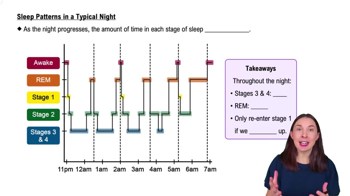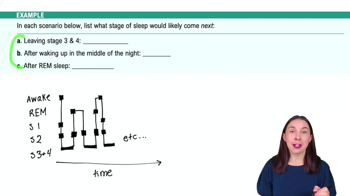Table of contents
- 1. Introduction to Psychology1h 43m
- 2. Psychology Research2h 20m
- 3. Biological Psychology2h 41m
- 4. Sensation and Perception28m
- 5. Consciousness and Sleep32m
- 6. Learning41m
- 7. Memory34m
- 8. Cognition37m
- 9. Emotion and Motivation35m
- 10. Developmental Psychology33m
- 11. Personality48m
- 12. Social Psychology41m
- 13. Stress and Health41m
- 14. Psychological Disorders44m
- 15. Treatment47m
5. Consciousness and Sleep
Sleep
Struggling with Psychology?
Join thousands of students who trust us to help them ace their exams!Watch the first videoMultiple Choice
The _____ is the internal clock that tells people when to wake up and when to fall asleep.
A
amygdala
B
hippocampus
C
pons
D
suprachiasmatic nucleus
 Verified step by step guidance
Verified step by step guidance1
Identify the function of the internal clock in the human body, which is responsible for regulating sleep-wake cycles.
Understand that the internal clock is part of the circadian rhythm system, which is influenced by external cues like light and darkness.
Recognize that the suprachiasmatic nucleus (SCN) is a small region in the brain located in the hypothalamus, which plays a crucial role in controlling circadian rhythms.
Differentiate the SCN from other brain structures such as the amygdala, hippocampus, and pons, which have different functions related to emotions, memory, and basic life functions, respectively.
Conclude that the suprachiasmatic nucleus is the correct answer as it is the primary internal clock that regulates when to wake up and when to fall asleep.

 3:25m
3:25mWatch next
Master Circadian Rhythms with a bite sized video explanation from Hannah Gordils
Start learningRelated Videos
Related Practice


































































































![Race, Genes and IQ Differences | Bret Weinstein [Mini Clip]](https://img.youtube.com/vi/IztL_m3pd70/mqdefault.jpg)



































































































